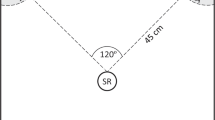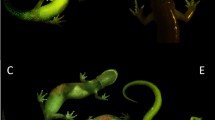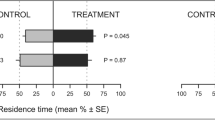Abstract
THE sensory bases of species and population mate preferences are well known1–3; in frogs properties of the female auditory system influence such preferences2,3. By contrast, there is little understanding of how sensory characteristics could result in sexual selection within a population. One possible mechanism is that females are more sensitive to male courtship signals that deviate from the population mean. We document this mechanism in the frog Physalaemus pustulosus. Female basilar papilla tuning is biased toward lower-than-average frequencies in the 'chuck' portion of the male's call, explaining female preference for the lower-frequency chucks produced by larger males. The tuning does not differ between P. pustulosus and its close relative P. coloradorum, a species in which males never evolved the ability to produce chucks; thus the female tuning evolved before the chuck and therefore the chuck played no role in the evolution of the preference. This allows us to reject two popular hypotheses for the evolution of this female preference (runaway sexual selection and natural selection) in favour of a third: sexual selection for sensory exploitation.
This is a preview of subscription content, access via your institution
Access options
Subscribe to this journal
Receive 51 print issues and online access
$199.00 per year
only $3.90 per issue
Buy this article
- Purchase on Springer Link
- Instant access to full article PDF
Prices may be subject to local taxes which are calculated during checkout
Similar content being viewed by others
References
Alcock, J. Animal Behaviour (Sinauer, Sundertand, 1988).
Ryan, M. J. Am Scient (in the press).
Ryan, M. J. & Wilczynski, W. Science 240, 1786–1788 (1988).
Ryan, M. J. Science 209, 523–525 (1980).
Ryan, M. J. Evolution 37, 261–272 (1983).
Ryan, M. J. J. comp. Physiol. 150, 217–221 (1983).
Ryan, M. J. The Tungara Frog, A Study in Sexual Selection and Communication (University of Chicago Press, 1985).
Rand, A. S. & Ryan, M. J. Z Tierpsychol. 57, 209–214 (1981).
Wilczynski, W. & Capranica, R. R. Prog. Neurobiol. 22, 1–30 (1984).
Zakon, H. H. & Wilczynski, W. in The Evolution of the Amphibian Auditory System (eds Fritzsch, B, Ryan, M. J., Wilczynski, W., Hetherington, T. E. & Walkowiak, W.) 125–155 (Wiley, New York, 1988).
Ryan, M. J. & Rand, A. S. Evolution (in the press).
Fritzsch, B., Ryan, M. J., Wilczynski, W., Hetherington, T. E. & Walkowiak, W. eds The Evolution of the Amphibian Auditory System (Wiley, New York, 1988).
Walkowiak, W., Capranica, R. R. & Schneider, H. Behav. Processes 6, 223–237 (1981).
Fisher, R. A. The Genetical Theory of Natural Selection 2nd edn (New York, Dover, 1958).
Lande, R. Proc. natn. Acad. Sci. U.S.A. 78, 3721–3725 (1981).
Kirkpartick, M. Evolution 36, 1–12 (1982).
Zahavi, A. J. theor. Biol. 53, 205–214 (1975).
Andersson, M. B. Evolution 40, 804–816 (1986).
West-Eberhard, M. J. Proc. Am. phil. Soc. 123, 222–234 (1979).
Endler, J. A. & McClellan, T. A. Rev. Ecol. Syst. 19, 395–421 (1988).
Arak, A. in Mate Choice (ed. Bateson, P.) 181–210 (Cambridge University Press, 1983).
Ryan, M. J. Oxford Surv. Evol. Biol. (in the press).
Cannatella, D. C. & Duellman, W. E. Copeia 1984, 902–921 (1984).
Ryan, M. J. & Drewes, R. C. Biol. J. Linn. Soc. Lond. (in the press).
Author information
Authors and Affiliations
Rights and permissions
About this article
Cite this article
Ryan, M., Fox, J., Wilczynski, W. et al. Sexual selection for sensory exploitation in the frog Physalaemus pustulosus. Nature 343, 66–67 (1990). https://doi.org/10.1038/343066a0
Received:
Accepted:
Issue Date:
DOI: https://doi.org/10.1038/343066a0
This article is cited by
-
Survival of the luckiest
International Review of Economics (2024)
-
Conserved chromatin and repetitive patterns reveal slow genome evolution in frogs
Nature Communications (2024)
-
Chemical communication and its role in sexual selection across Animalia
Communications Biology (2023)
-
Decoupled auditory perception from acoustic signal divergence hinders species recognition in territorial poison frogs
Behavioral Ecology and Sociobiology (2023)
-
Lack of Female Preference for Nuptial Gifts May Have Led to Loss of the Male Sexual Trait
Evolutionary Biology (2023)
Comments
By submitting a comment you agree to abide by our Terms and Community Guidelines. If you find something abusive or that does not comply with our terms or guidelines please flag it as inappropriate.



